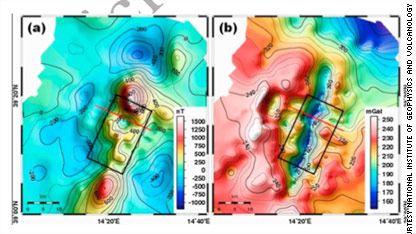
© International Institute of Geophysics and VolcanologyThese images of the Marsili volcano show magnetic and gravity anomalies, which researchers say increase chances of a collapse.
Rome - Europe's largest undersea volcano could disintegrate and unleash a tsunami that would engulf southern Italy "at any time", a prominent vulcanologist warned in an interview published Monday.
The Marsili volcano, which is bursting with magma, has "fragile walls" that could collapse, Enzo Boschi told the leading daily
Corriere della Sera."It could even happen tomorrow," said Boschi, president of the National Institute of Geophysics and Volcanology (INGV).
"Our latest research shows that the volcano is not structurally solid, its walls are fragile, the magma chamber is of sizeable dimensions," he said. "All that tells us that the volcano is active and could begin erupting at any time."
